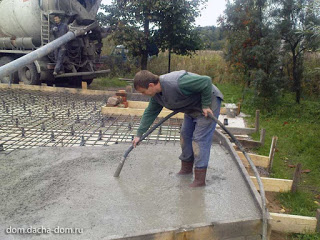Concrete Vibration, Concrete Vibrators and its types
Quality of concrete depends on many factors among which the most vulnerable and defenseless is workmanship. During pouring the concrete and execution of work cautious supervision is imperative. The supervisor has to look for many things including the finishing of concrete, pouring quantity, at-site testing, unremitting and continual supply of material from the batching plant. Beside all those points a very important one is vibration of concrete by any suitable means or as specified by the contract documents of the project.
In the past the placing of concrete is always followed by some densification by means of ramming or punning but this old technique is superseded. The purpose of that ramming was to compact concrete to achieve maximum possible density of the concrete. This process is usually termed as consolidation of concrete.
Nowadays the concrete is consolidated by means of vibration. The freshly mixed concrete has always air bubbles which usually occupy 5 to 20 percent of the total volume of the concrete. These air bubbles are more in low-slump concrete and less in loose slump or high workable concrete. During pouring when vibrator (a device used to produce vibration effect for consolidation of concrete) is poked into the concrete the internal friction between coarse aggregates reduces to a suitable amount which results in fludifying the mortar and thus packing of the same is done. The purpose of vibration is to achieve a maximum possible close configuration of the coarse aggregate with respect to their shape.
As we all know that excess of everything is bad same is the case with vibration. The term over-vibration is used to define the amount of vibration that will result segregation in the concrete mass which is very destructive. Segregation is the separation of the fine and coarse materials like cement and sand get separated and the aggregates loose the coating of fines around them.
Therefore it is always advised to uniformly apply vibration within the concrete mass so that it is consolidated equally throughout. However, with a sufficiently stiff and well-graded mix, the ill effects of over-vibration can be largely eliminated.
Different vibrators require different consistency of concrete for most efficient compaction so that the consistency of the concrete and the characteristics of the available vibrator have to be matched. It is worth noting the flowing concrete although it may be self-levelling, does not achieve full compaction by gravity alone. However, the necessary duration of application of vibration can be reduced by about one-half compared with ordinary concrete.
The most widely used and efficient among the vibrators is the internal vibrator. It consists of a poker which is connected through a flexible drive with motor. The poker is immersed into the concrete which through harmonic forces induces the vibration within the concrete mass.
The frequency of vibration varies up to 12,000 cycles of vibration per minute minimum of which is 3500 to 5000 cycles per minutes but now a days 4000 to 7000 is favorable.
The duration of immersion as well as the radius of action of immersion depends on the consistency of the mix but in most of the cases the poker needs to be immersed after every 0.5 to 1 m for duration of 5 to 30 seconds.
Completion of compaction through vibration is judged by the appearance of the surface of the concrete. It should be as so that it does not have honeycombed surface and also should not be having excess of mortar. The poker should be with-drawl slowly at rate of about 80 mm / sec so that the gap or space being taken by the poker gets level without any entrapped air within the concrete volume.
External vibrators are usually used for precast or in situ sections of such shape or thickness that an internal vibrator cannot be conveniently used.
During usage of external vibrators it is ensured that the thickness of layer of concrete is not large so as to avoid the air to get entrapped. The position of the vibrator may need to change in such cases during pouring of concrete.
External vibrators are rigidly clamped to the formwork resting on elastic support, so that both the form and the concrete are vibrated. As a result, a considerable proportion of the work done is used in vibrating the formwork.
In such cases formwork is clamped to the vibrator unlike external vibrators where vibrator is fixed to the formwork. Usually a rapidly rotating eccentric mass is fixed to the bottom of the table that makes it to vibrate in a circular motion. With two shafts rotating in opposite directions, the horizontal component of vibration can be neutralized so that the table is subjected to a simple harmonic motion in the vertical direction only.
A vibrating table provides a reliable means of compaction of precise concrete and has the advantage of offering uniform treatment.
A surface vibrator applies vibration through a flat plate direct to the top surface of the concrete. In this manner, the concrete is restrained in all directions so that the tendency to segregate is limited; for this reason, a more intense vibration can be used.
An electric hammer can be used as a surface vibrator when fitted with a bit having a large flat area, say 100 mm by 100 mm (4 in. by 4 in.)
One of the main applications is in compacting test cubes. A vibrating roller is used for consolidating thin slabs. For road construction various vibrating screeds and finishers are available.













